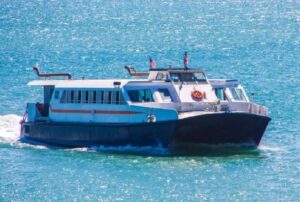 Southern Maryland, comprising Charles, Calvert, and St. Mary’s counties, stands on the brink of significant transformation with the proposed Chesapeake Bay Passenger Ferry System. Announced at the Maryland Association of Counties (MACo) Conference on August 15, 2024, the findings of a feasibility study conducted by the Chesapeake Bay Passenger Ferry Consortium outline a visionary plan that could reshape transportation, bolster economic growth, and enhance community connectivity across the region.
Southern Maryland, comprising Charles, Calvert, and St. Mary’s counties, stands on the brink of significant transformation with the proposed Chesapeake Bay Passenger Ferry System. Announced at the Maryland Association of Counties (MACo) Conference on August 15, 2024, the findings of a feasibility study conducted by the Chesapeake Bay Passenger Ferry Consortium outline a visionary plan that could reshape transportation, bolster economic growth, and enhance community connectivity across the region.
A New Era of Connectivity for Southern Maryland
For decades, Southern Maryland has been somewhat isolated from the rest of the state due to its unique geography. The Chesapeake Bay Passenger Ferry System aims to change that by providing a direct water route connecting Southern Maryland’s coastal towns with other key destinations across the Bay. This new mode of transportation would enhance accessibility, making it easier for residents to commute and for tourists to explore the region’s rich cultural and natural attractions.
Linking Communities and Enhancing Mobility: The ferry system would connect prominent locations such as Solomons Island, Leonardtown, and St. Mary’s City, making these areas more accessible to both Maryland residents and out-of-state visitors. By reducing travel times across the Bay, the ferry could provide a convenient alternative to driving, especially for those traveling from densely populated areas like Annapolis or Baltimore.
Improving Access to Local Destinations: Southern Maryland is home to several historical sites, state parks, and waterfront attractions that could benefit from increased visitor traffic. Sites like Historic St. Mary’s City and the Calvert Marine Museum in Solomons Island could see more tourists, driving economic benefits for local businesses and encouraging greater preservation efforts.
The ferry system promises to be a catalyst for economic growth in Southern Maryland. By increasing foot traffic to coastal towns, the ferry service could stimulate local economies, particularly in the tourism and hospitality sectors.
Boosting Local Businesses: Increased visitor numbers would naturally lead to higher demand for local services, from restaurants and cafes to retail stores and recreational businesses. Local entrepreneurs, such as artisans, bed-and-breakfast owners, and tour operators, would have more opportunities to showcase their products and services, leading to economic revitalization in the region.
Creating New Jobs: The implementation of the ferry system is expected to create various job opportunities across Southern Maryland. The need for ferry operators, maintenance personnel, hospitality staff, and other related roles would provide much-needed employment, particularly in St. Mary’s and Calvert counties, where job growth is crucial for sustaining community well-being.
Enhancing Tourism and Recreation
Southern Maryland’s rich cultural heritage and natural beauty have always been attractive to tourists, but the ferry system could significantly amplify this appeal by making these treasures more accessible.
Promoting Southern Maryland’s Attractions: The ferry would offer tourists a unique way to explore the region, highlighting Southern Maryland’s nearly 500 miles of shoreline, its charming small towns, and historical sites. For example, visitors could easily travel between destinations like Solomons Island and Leonardtown, experiencing local festivals, seafood restaurants, and the serene beauty of the Chesapeake Bay.
Expanding Recreational Activities: With improved water access, the ferry could facilitate various recreational activities, such as boating, kayaking, and fishing. It would also support events like eco-tours and historic walks, further enriching the visitor experience and promoting environmental stewardship.
Environmental and Community Benefits
Beyond economic and tourism advantages, the ferry system aligns with Southern Maryland’s goals for sustainable development and community cohesion.
Supporting Sustainable Transportation: By offering a water-based transportation alternative, the ferry system could help reduce road congestion and lower greenhouse gas emissions. This aligns with environmental goals and appeals to eco-conscious travelers seeking sustainable ways to explore new areas.
Strengthening Community Ties: The ferry system would not only serve tourists but also residents, providing a new way for people to connect with neighboring communities. This could foster a greater sense of regional identity and cooperation, benefiting local events, cultural exchanges, and regional planning efforts.
Challenges and Future Prospects
While the benefits of the Chesapeake Bay Passenger Ferry System are clear, several challenges must be addressed to make this vision a reality. Securing funding, navigating regulatory requirements, and ensuring local community support are critical steps in moving forward. However, the positive reception from community partners and stakeholders, with 67% expressing interest in the service, suggests a strong foundation for progress.
Conclusion
The Chesapeake Bay Passenger Ferry System represents a transformative opportunity for Southern Maryland. By enhancing connectivity, boosting the local economy, and promoting sustainable tourism, the ferry could play a vital role in revitalizing the region. As Southern Maryland looks to the future, this project symbolizes a chance to embrace its rich maritime heritage, connect its communities, and welcome visitors to experience the unique charm and beauty of this remarkable part of Maryland. With thoughtful planning and community engagement, the ferry system could become a cornerstone of Southern Maryland’s future, bringing renewed energy and prosperity to the region.


